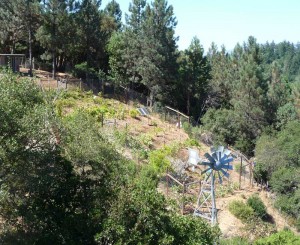Permaculture can be considered as a systematic way to integrate green and sustainable agriculture ideas. The ideas were fleshed out in Australia in the 1970’s, but much core thinking about permaculture is based on cultures that had long duration ecological success, like rice growers in Bali. One of the key principles is to observe your environment before taking action. Another is to work with what nature has provided rather than fighting against it.
There is a five acre permaculture project with almost thirty years of history in the hills overlooking Dry Creek Valley. The owner is devoted to sustainable development on the property and it shows the results of the decades of time invested.

His water system now includes rain catchment from both sides of the roof. There are three ponds with significant water holding capacity. There is an extensive network of shaped furrows on the hillside to slow down rain water runoff and give it time to soak into the ground. Fast surface runoff has been slowed, diverted, and held on the property longer to give time for absorption. As a consequence, an old well on the property with declining production is now producing more water than ever before. His high production well sits idle most of the year, valuable back up for a future that could be much more dry than recent decades. That’s just the water. Other systems show a similar attention to detail.

Another principle of Permaculture is to design with concentric zones starting with the house as the center in Zone 0. Working outward there are vegetable gardens and kitchen herbs in Zone 1. Zone 2 has fruit trees, berries, and other crops with less need for daily attention. Beyond that are chickens and llamas with their important contributions to soil fertility and pest control.
A life spent paying attention to nature isn’t everyone’s dream, but Sonoma County permaculture is well established with a significant population of people practicing and teaching permaculture and refining what it means to be a sustainable agricultural person in modern California.
